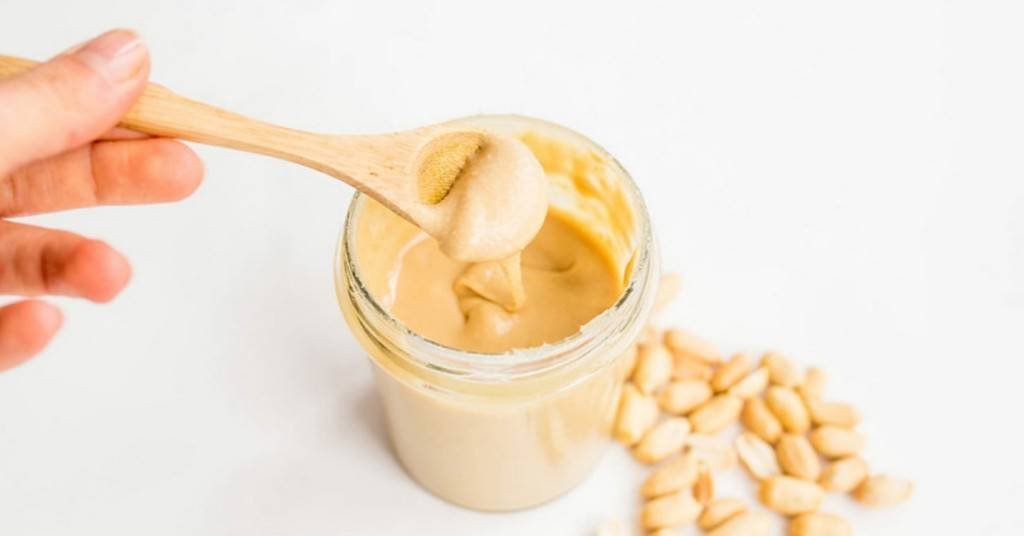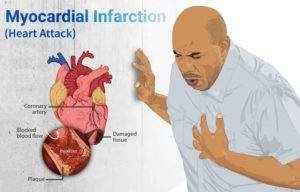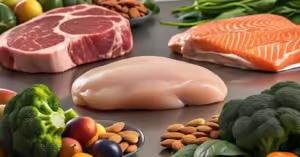
Table of Contents
Peanut butter is a popular nutrient-packed spread. A 100g of natural peanut butter with no additives contains about 594kcal of energy, 25g of plant protein, 62mg of calcium, 2.25mg of iron, 9.4g of dietary fiber, and 50g of total fats but no trans-fats.
It’s made from roasted peanuts that were ground sufficiently to produce a paste. Commercial peanut butter often comes with added ingredients like vegetable oil, salt, and trans-fats. With fewer added ingredients, the healthier.
In this article, we’ll take a look at the nutrition of peanut butter, its health benefits, and the known side effects.
Types of peanut butter
1. Natural peanut butter. This has only the basic ingredients of roasted peanuts and salt without any of the additives meant to improve the form and shelf life. The problem with this is that you may have to stir it before use each time as the oil usually separates from the semi-solid portion.
Refrigeration will be required to maintain the freshness. This category includes organic peanut butter as well.
2. Regular or conventional peanut butter. These are peanut butter with added hydrogenated oils which keep the peanut oil from separating from the semi-solid components. The hydrogenation of oils is over a century old and it makes food oils semi-solid at room temperature.
When these oils are added to peanut butter it also adds to its shelf life, makes it easier to ship, and you may not need refrigeration to maintain the butter’s freshness. However, it has been associated with some health risks.
The Food and Drug Administration (FDA) issued guidelines that limit the amount of all additives in peanut butter to not more than 10% of the entire content.
3. No-stir peanut butter. This has similar physical characteristics to conventional peanut butter but differs in composition. This is because rather than the use of partially hydrogenated edible oils, refined palm oil is used. This comes with the health risks of trans-fats too.
Moreover, the refined palm oil additive is not included in the Food and Drug Administration’s regulation on what peanut butter must contain. For this reason, it is tagged “peanut butter spread”, to distinguish it from the FDA standard peanut butter.
The Nutrient composition.
| Nutrient | Amount | Derivation |
|---|---|---|
| Energy | 594Kcal | Calculated from the value per serving size measure. |
| Protein | 25g | Calculated from the value per serving size measure. |
| Total Lipid | 50g | Calculated from the value per serving size measure. |
| Carbohydrate | 21.9g | Calculated from the value per serving size measure |
| Total dietary fiber | 9.4g | Calculated from the value per serving size measure. |
| Total sugars plus NLEA | 3.12g | Calculated from the value per serving size measure. |
| Total saturated fatty acids | 6.25g | Calculated from the value per serving size measure. |
| Iron | 2.25g | Calculated from daily value percentage per serving size measure |
| Calcium | 62g | Calculated from daily value percentage per serving size measure |
From the table above, you’ll find peanut butter normally has no trans-fats or cholesterol. These are introduced by the introduction of additives. It does contain some saturated fatty acids though.
It’s a good source of plant protein and Americans embraced it during the Second World War to make up for animal protein shortages at that time.
Peanut butter also has identifiable amounts of other nutrients like Copper, Folate, and Magnesium. Manganese, Potassium, various vitamins B, vitamin E, and Zinc.
Nutrition in peanut butter cookies.
These are crunchy cookies developed in the early 20th century in the US. It’s so named because it has peanut butter as the main ingredient and may even have pieces of peanuts depending on the type of peanut butter that was used.
The protein and fiber content of these cookies keep you feeling full longer than the average cookie made from refined carbs and sugar. The fiber content enhances the movement of digested food and wastes through your intestines thereby making you less prone to constipation than other cookies. It is believed cookies such as this also reduce your chances of developing type 2 diabetes.
Peanut butter cookies have the following nutrition facts for a small 2 inches diameter cookie:
| Nutrient | Amount | Percentage daily value |
|---|---|---|
| Energy | 91cal | 4% |
| Total fat | 4.9g | 8% |
| Saturated fat | 2.1g | 11% |
| Trans fat | 0.1g | 5% |
| Cholesterol | 13mg | 4% |
| Sodium | 80mg | 3% |
| Potassium | 41mg | 1% |
| Total carbohydrates | 11g | 4% |
| Dietary fiber | 0.4g | 2% |
| Sugars | 6.6g | |
| Protein | 1.6g | 3% |
In some instances where no percentage daily value figure was given, I had to do the maths based on a 2,000cal diet to reduce the empty spaces a little.
Nutrition in powdered peanut butter.
This is made by pressing out most of the oil from roasted peanuts and grinding the product into powder. Technically it has much less fat than you would expect from the usual peanut butter. You prepare it for eating by mixing the powder with some water.
For some people with existing health concerns, the powdered form may be a better way of enjoying peanut butter.
Below is the expected nutrition in two tablespoons of powdered peanut butter.
| Nutrient | Amount | Percentage daily value |
|---|---|---|
| Energy | 45cal | 2% |
| Protein | 5g | 10% |
| Fat | 1.5g | 3% |
| Carbohydrates | 5g | 2% |
| Fiber | 2g | 9% |
| Sugars | 1g | 3% |
Percentage daily values were calculated based on a 2,000cal diet.
6 Health benefits of peanut butter.
1. Blood sugar control: One of the reasons for type 2 diabetes is the body’s resistance to insulin. Oleic acids and Omega-6 fatty acids are known to reduce this resistance thereby helping to restore the normal cellular metabolism of glucose. This helps to maintain normal blood glucose levels.
2. Weight loss: The protein, fats, and fiber in peanuts help you feel full and less hungry thereby reducing your overall food intake. Eating less means a reduced tendency for weight gain or even weight loss if you aim for that as has been acknowledged in the American Journal of Clinical Nutrition (AJCN).1
3. Reduction of risk of heart disease: Peanut butter is reached in mono- and poly-unsaturated fatty acids, Niacin, and magnesium which are known for improving your heart’s health. It also contains an antioxidant called Resveratrol. This is known to reduce the oxidation of low-density lipoproteins (LDL) that leads to the hardening of your arteries and heart disease.
For this reason, they reduce your risk of heart-related diseases as has been stated in a Journal of Internal Medicine.2
4. Muscle building: The rich protein content of peanut butter adds to your body’s protein needs. Proteins, as we know them, are used for the repair of worn-out or damaged tissues and the building of muscles.
5. Anti-cancer: The butter contains an antioxidant called Coumaric acids which works to prevent cancer as published in the National Library of Medicine (NLM).3 It also reduces the risk of benign breast diseases that increase the risk of breast cancer as contained in the Journal of the National Library of Medicine.4
People with a family history of cancer could have their risk of coming down with the disease reduced by eating peanut butter. Share on X6. Blood pressure management: An anti-oxidant present in peanut butter, Resveratrol, is known to relax blood vessels thereby lowering blood pressure.
8 Disadvantages or side effects of Peanut butter.
1. Allergies: Millions of people have known allergies to nuts of which peanut is one. This has at times actually proven fatal. If you have such allergies you may need to avoid peanut butter according to the National Institute of Health (NIH) on Peanut Allergy.5
2. Neurological problems from Aflatoxin contamination: This is a type of mycotoxin. It’s a fungus that could contaminate agricultural produce like peanuts and may be found in peanut butter that’s prepared from contaminated nuts. The toxin is neurotoxic and could cause dementia and Parkinsonism.
3. Impaired Absorption of nutrients: The butter has substances like phytic acid that could reduce your body’s ability to absorb nutrients like zinc and iron according to the Institute of Food Science and Technology (IFST).6
4. Weight gain: Peanut butter is high in calories which have to be taken into consideration. Excess of it could result in extra caloric intake that could lead to weight gain
5. Heart disease and hypertension: A lot of commercial peanut butter has added sugars, hydrogenated oils, and other additives that could result in health problems ranging from heart diseases to hypertension. Taking peanut butter in excess could significantly increase your chances of coming down with these diseases.

6. Indigestion: Peanut butter contains a lot of fats. These take longer to digest so eating an excess of them could result in some form of indigestion.
7. Gastroesophageal reflux or heartburn: This is another problem that could result from excess consumption of peanut butter. When taken in excess, its high-fat content could trigger relaxation of the lower esophageal sphincter.
This sphincter prevents stomach acid from reaching the esophagus. Its undue relaxation will cause the acidic content to reach the esophagus giving rise to the symptoms of heartburn.
8. Liver failure or cancer: A study has shown that aflatoxin doesn’t end in the causation of neurological problems but also liver cancer and failure.7
9. Greater risk of all-cause, cancer, and cardiovascular mortality: Peanuts have a high omega-6/omega-3 ratio. A study has associated this with all-cause, cancer, and cardiovascular mortality.8
Keep in touch by signing up for our newsletter:
Consumption tips and closing Remarks.
Avoid eating peanut butter that seems to have grown mold. You may not know when it’s the dangerous Aflatoxin you are dealing with. Also, please avoid the butter if you have a known allergy to peanuts as this can prove fatal as stated earlier in this article.
Though the Food and Drug Administration has set the standard that peanut butter must be made up of at least 90% peanut butter, the best kinds of butter are those with little to no additives.
Natural, and organic peanut butter, which are both essentially similar, meet this criterion.
However, organic kinds of peanut butter are those certified to be made from peanuts that were grown without artificial fertilizers or pesticides. Natural peanut butter may not last more than 4 months unless refrigerated. Refrigeration could extend its edible period to 6 months.
Peanut butter has numerous health benefits but eating them in excess should be avoided. Meanwhile, you may also want to find out about the nutritional value of eggs.
References.
- Bes-Rastrollo, M., Wedick, N. M., Martinez-Gonzalez, M. A., Li, T. Y., Sampson, L., & Hu, F. B. (2009). Prospective study of nut consumption, long-term weight change, and obesity risk in women. The American Journal of Clinical Nutrition, 89(6), 1913-1919. https://doi.org/10.3945/ajcn.2008.27276 ↩︎
- Luu HN, Blot WJ, Xiang Y, et al. Prospective Evaluation of the Association of Nut/Peanut Consumption With Total and Cause-Specific Mortality. JAMA Intern Med. 2015;175(5):755–766. doi:10.1001/jamainternmed.2014.8347 ↩︎
- Hu, X., Yang, Z., Liu, W., Pan, Z., Zhang, X., Li, M., Liu, X., Zheng, Q., & Li, D. (2020). The Anti-tumor Effects of p-Coumaric Acid on Melanoma A375 and B16 Cells. Frontiers in Oncology, 10. https://doi.org/10.3389/fonc.2020.558414 ↩︎
- Berkey, C. S., Willett, W. C., Tamimi, R. M., Rosner, B., Frazier, A. L., & Colditz, G. A. (2013). Vegetable protein and vegetable fat intake in pre-adolescent and adolescent girls, and risk for benign breast disease in young women. Breast Cancer Research and Treatment, 141(2), 299. https://doi.org/10.1007/s10549-013-2686-8 ↩︎
- Burks AW. Peanut allergy. Lancet. 2008 May 3;371(9623):1538-46. doi: 10.1016/S0140-6736(08)60659-5. PMID: 18456104. ↩︎
- Lopez, H. W., Leenhardt, F., Coudray, C., & Remesy, C. (2002). Minerals and phytic acid interactions: Is it a real problem for human nutrition? International Journal of Food Science & Technology, 37(7), 727-739. https://doi.org/10.1046/j.1365-2621.2002.00618.x ↩︎
- Lien, W., Wang, X., Pan, H., & Ling, P. (2019). Assessing Aflatoxin Exposure Risk from Peanuts and Peanut Products Imported to Taiwan. Toxins, 11(2). https://doi.org/10.3390/toxins11020080 ↩︎
- Yuchen Zhang, Yitang Sun, Qi Yu, Suhang Song, J Thomas Brenna, Ye Shen, Kaixiong Ye (2024) Higher ratio of plasma omega-6/omega-3 fatty acids is associated with greater risk of all-cause, cancer, and cardiovascular mortality: A population-based cohort study in UK Biobank eLife 12:RP90132
https://doi.org/10.7554/eLife.90132.3↩︎































































































































































I like this blog so much, saved to bookmarks.
I think you made some good points in here.
You’re so cool! I don’t suppose I’ve read anything presented like this before. So good to find somebody with some authentic thoughts on this subject. really thank you for starting this up. this web site is something that is needed on the web, somebody with a bit originality. useful job for bringing one new thing to the web!